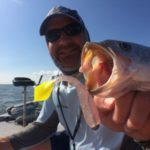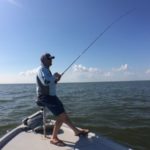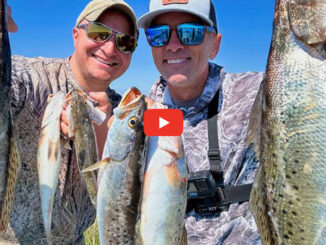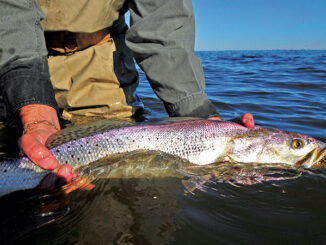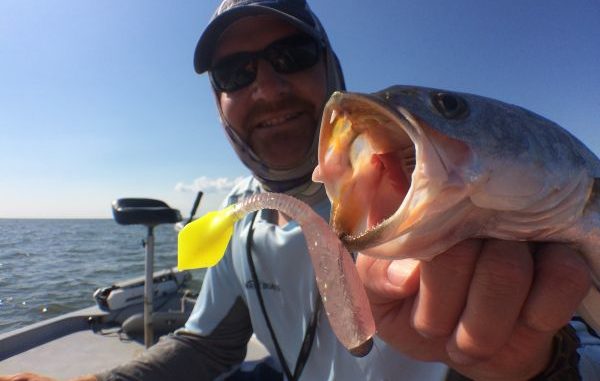
While trout anglers along most of the coast have to resort to live bait this month, this guide knows plastics will still produce in Dularge. You just need to know where to go.
Capt. Travis Miller learned a few years ago that one of his favorite — and perhaps his favorite — platforms was going to be removed from his Dularge waters.
Miller caught beaucoup specks around this platform, but his Picket fish would only be a distant memory.
The angler, like the other Dularge guides, was certainly upset. He didn’t know what was in store and thought he was going to lose one of his prime fish-producing areas.
Fieldwood Energy sure enough pulled the platform up, but the Coastal Conservation Association, the state of Louisiana and the Apache Corporation teamed up to put in an artificial reef that is now chock-a-block full of trout.
And now, with the placement of the bottom structure, the fishing at the Pickets is just as good, if not better, than it was when the platform was still there.
Miller demonstrated how loaded with fish this reef was on a recent trip out of the Reel Inn Lodge in Dularge. He and his guests wore out solid keeper speckled trout — and some nice fish at that.
They had yellowmouths up to 2 pounds.
“Last year was my first year fishing this reef,” Miller said. “It’s been surprisingly productive.”
Miller likes to drift the reef, and tries to find a “sweet spot” on it. Once that is found, he anchors until the bite shuts down.
A trolling motor is a vital piece of equipment when fishing the reef, the owner of Miller Time Charters said.
“Whenever I approach any reef or any rig, I like to troll first if possible,” Miller explained. “I find you limit yourself if you anchor up right away.”
Miller casts a ¼-ounce jighead over the reef and lets it fall straight to the bottom. He then gently works the lure in the current, hopping it off the bottom.
The new reef is just one of the many areas that can be productive in May. The fantastic thing about fishing out of Dularge is all the options the area offers.
Anglers with big bay boats are always chomping at the bit to catch speckled trout at the oil-field structures on the outside, and, according to Miller, May marks the beginning of phenomenal fishing at those outside platforms and wellheads.
“Coon Point all the way to the Mardi Gras (rig) can be good,” he said. “It’s a little early to catch fish out at Blue Point, but that’s not to say you can’t do it.”
Properly approaching a rig — again, using a trolling motor instead of anchoring right away — is absolutely vital, according to Miller.
“I usually set up and try to drift with the wind,” he said. “I always try to let the wind and tide direct me because I don’t really want to fight that with my trolling motor.”
Miller casts at all angles of the platform and sides of the structure. He generally finds trout to be on the upcurrent side of the platform — but that’s not always the case, which forces him to try all around the platform.
If no fish are found, Miller wastes no time getting his Blue Wave back on plane and pointed toward a different structure.
If fish are found, though, Miller works the area over well before moving on.
“As soon as I find a fish, I make sure I hold that position and fish it thoroughly,” he said. “If I don’t catch a fish, I’ll give it five minutes.
“I don’t waste a lot of time, because if the fish are there you are going to know it.”
There are certain times of the year — spring and fall — during which catching one fish here and another there is typical, and if you move around all day you’ll typically put together a nice mess of fish.
This, however, does not hold true during the summer, the guide said.
“A lot of times, when you fish the outside you don’t get just one fish here or there,” Miller said. “A lot of times you get at least 15 to 20 (bites) per spot.”
Miller is a big fan of double rigs when he is fishing offshore. He uses ¼-ounce jigheads, and prefers Matrix Shads and Vortex Shads.
The color he fishes depends on water clarity.
“In the cleaner water, I go with a shrimp creole Matrix or a kamikaze-colored Vortex Shad,” Miller said. “As the water gets dirty, I’ll go to a green hornet or an avocado Matrix Shad.
“Toward the end of the summer, I switch to just avocado because I find the fish start turning to croakers, and that avacado mimics them well.”
Miller likes double rigs because they provoke a more-aggressive strike than other baits.
Working your double rigs correctly is crucial to catching fish out at the oil-field structures.
“You always have to let the baits go to the bottom,” Miller explained. “The only way I don’t let the baits go to the bottom is if I already have a fish on them.
“For some reason, it doesn’t matter what time of year you’re fishing offshore, those fish are going to hug the bottom, no matter what.”
Miller said some days trout will try to rip the rod out of your hand and other days will resemble a subtle wintertime bite.
In order to feel those soft taps, Miller makes sure to be spooled up with braided line.
“I am a big braid guy,” he said. “It allows me, when I’m popping that bait (off the bottom), to feel that ‘tick.’”
Dularge is a unique place in that while the rest of the coast is battling with the expense and hassle of live bait, plastics continue working.
With live shrimp costing 50 cents apiece in some places, being able to fish plastics virtually all summer is a huge advantage.
And Miller fishes plastics until the water gets too hot.
“I try to stick with plastics all summer, but as the water gets in the high 80s, (trout) do get lethargic and want that live bait,” he said.
A certain tide direction is a big advantage this time of year, according to Miller.
“I am a big incoming tide fan when I’m fishing offshore because it brings in that clean, salty water (from the Gulf),” he said.
And the benefits of fishing these platforms comes in more than numbers.
“I find you catch a lot of bigger fish in May,” he said. “I find the smaller fish are inside, and if you can get there before the masses find out that they are offshore you can lay into some really nice 3-pound fish.”
Editor’s note: Capt. Travis Miller can be reached at 985-981-6434 or online at www.miller-timefishingcharters.com.
